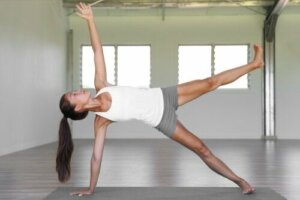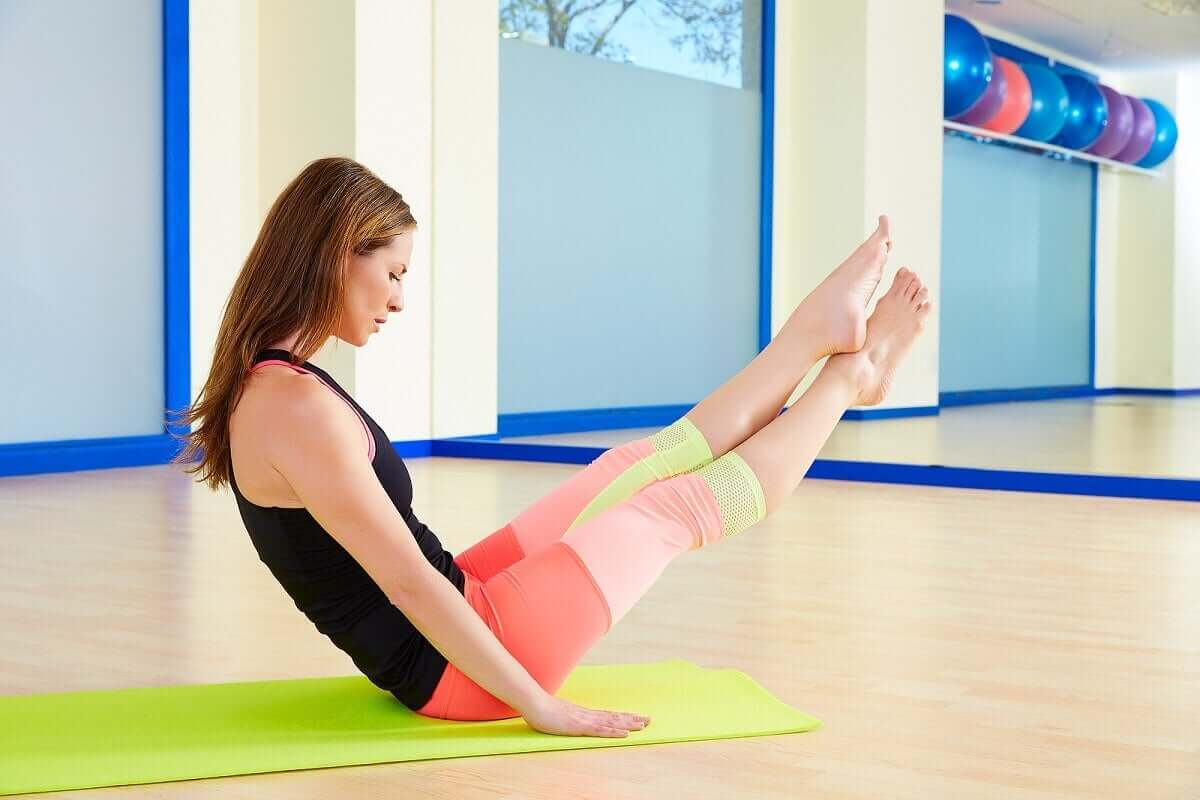The Best Pilates Exercises: Advanced Level


Reviewed and approved by the doctor Leonardo Biolatto
Advanced level Pilates exercises are ideal for those who have already spent several weeks working on the intermediate routines. At the advanced stage, training has positive effects on posture, chronic pain, and overall life quality.
And, as an article published in the Muscles, Ligaments, and Tendons Journal explains, these exercises are designed to improve strength and muscular resistance, as well as flexibility, posture, and balance.
Advanced Pilates: floor or machine exercises?
Although there are technical differences between practicing Pilates on the floor and practicing with a machine, you can train at the advanced level with either of the two. In a general sense, you’ll receive the same benefits and reach your objectives.
Having said that, you must keep in mind that working with machines will mean you can work with external weights. Nevertheless, in both variations, you can include equipment to compliment your workout, like a Pilates ball, resistance bands, or a magic circle.
Pilates exercises at an advanced level
One of the biggest advantages of Pilates is that you can work out at different levels, according to your physical capacity. As such, once you have completed the intermediate level, you can move on to the advanced level. Which positions are included at this stage?
1. Control and balance
The control and balance exercise positively impacts the strength and flexibility of the flexors and hip extensors. As such, it contributes to strengthening the middle of the back.
How to do it:
- To start, inhale whilst you do a rollover.
- Once you have your legs over your head, open your arms in a circular motion behind you to grab your feet.
- Exhale softly whilst you bring your feet up.
- To add more intensity and extension to your hips, do two little bounces with your legs raised.
- Inhale whilst you keep your core and pelvis still so that you can move your legs simultaneously; move one up and the other down.
- Do this exercise six times. Then, put both legs behind your head so that your feet touch the floor.
- Lastly, bring your legs back down slowly, until you’re lying flat on the mat or mattress.

2. The double leg stretch
Due to its complexity, this exercise should only be done by those operating at an advanced level. Why? Because poor practice of this position can cause injuries. However, doing it correctly strengthens the abdominal muscles and the flexors in the neck. Furthermore, it strengthens movement coordination.
How to do it:
- On your back, or in a supine position, lift your legs towards your chest and place your hands on your shinbones, very close to your ankles.
- Inhale and exhale whilst you pull your navel towards your spin. Lift your head from the mat and bring your chin into your chest.
- The upper part of your body will be supported by your shoulder blades.
- First, lift your arms at a 45-degree angle; they should be in line with your ears.
- Later, lift your legs at the same angle, and stay in this position for a few seconds.
- Then, move your arms back down in a circular motion. Flex your legs, taking hold of your shinbones.
- Inhale to lift your limbs. Hold your breath and exhale to return to your original position.
- Repeat this 6 to 8 times.
You may also be interested in: Four Simple Pilates Exercises for Beginners
3. The crab
One of the advantages of this type of position is that it helps to improve the core’s stability. In a similar vein, it helps to improve the flexibility of your hamstrings and strengthen your balance.
How to do it:
- First, sit on a mat with your legs extended and your ankles together.
- Flex your knees and cross your ankles.
- Hug your legs and grab your ankles from the outside.
- Keep your head down and your abdominal muscles tight.
- Inhale and roll backward, and exhale to lift your legs above your head. Touch the floor with your feet and inhale.
- After doing that, exhale to roll forwards until your head reaches the yoga mat.
- Inhale and exhale to roll back.
- Repeat this 3 to 4 times.
- To finish, roll forwards, drop your heels, extend your legs, and drop your arms to your sides.
4. Rocking
This is a balance exercise that helps to strengthen your back and look after the spinal column. More specifically, it increases the torso’s stability and contributes to maintaining good posture.
How to do it:
- Lay down on the yoga mat face down, with your head to one side and your arms by your sides.
- Bend your right knee, bring it up, and take it with your right hand. Later, repeat this with the left side.
- Next, inhale and support yourself on your ankles whilst you lift your head, chest, and knees.
- Shift your balance to one side, and then the other, all the while ensuring that you maintain the half-moon pose.
- Exhale to go forward, and inhale to stand up.
- Remember that the rocking is in your breathing technique, and it should be kept natural to ensure it has an impact on the muscles.
- Keep your abdomen firm and your neck stretched.
- Do this five times.
5. The starfish
Just like the other advanced-level Pilates exercises that we have mentioned in this article, this position has the ability to activate specific muscles to improve the body’s stability. In fact, it helps to strengthen the gluteal muscles and the upper part of the body.
How to do it:
- Lay down face down, or in the prone position. Keep your legs extended and your arms in front of you.
- Inhale and exhale to stretch out the right arm and raise it from the floor, at the same time as you extend your left leg.
- Inhale and return both limbs to the floor simultaneously.
- Exhale to repeat the process with the left arm and right leg.
- Keep your back straight at all times.
- Repeat this 8 to 10 times.
6. Boomerang
Practicing advanced-level Pilates exercises also has a positive impact on cardiorespiratory health. Including the boomerang in your routine aids this, and also improves your control and balance.
How to do it:
- Firstly, sit up straight on your mat with your legs outstretched – one over the other and crossed at the ankle.
- Your hands should be kept in front. Inhale to begin the movement.
- Lift your hands and expel the air. In turn, lift your legs in their initial position.
- Let yourself lean back and lift your legs over your head. Your hands should stay in front of you, and you’ll support yourself on your shoulder blades.
- Now, inhale and change the position of your ankles – put the one that was on top underneath.
- Exhale as you return to your initial position; feet resting on the mat, arms outstretched behind you, and head down.
- Inhale again to bring your arms forwards, and repeat the movement.
- Do this 6 or 8 times.

Discover more: 6 Benefits of Doing Pilates Every Week
Advice for doing the advanced-level Pilates exercises
To do these exercises, it’s important to be consistent and disciplined. For this, you must first complete the activities at the beginner and intermediate stages; this way, the body will be prepared for a high level of difficulty. Likewise, it’s also important to take the following advice:
Warm-up
A good warm-up is essential when doing any physical conditioning method or routine. It prepares the body to start. It also contributes to the prevention of injuries in the muscles, tendons, ligaments, or joints.
Breath
At the advanced level, it’s imperative to manage your breathing technique, since the success of each routine relies heavily upon it. When breathing, your rib cage will expand outwards and upwards, whilst your spinal column lengthens to be able to allow the most air possible into your lungs.
Concentration
It’s important to ensure that each movement that makes up the routine is done with precision. As such, it’s just as important to concentrate on your breathing technique as the position itself.
Advanced-level Pilates exercises improve health
When included in a healthy lifestyle, Pilates exercises are useful to improve health and well-being. Its practice doesn’t only contribute to increasing muscular strength, but also increasing flexibility and stimulating cardiorespiratory health.
Nevertheless, it’s important to begin this practice gradually, until you reach the level of resistance that will allow you to move onto the advanced level. When possible, it’s best to do these exercises under the supervision of a professional. Bear that in mind!
All cited sources were thoroughly reviewed by our team to ensure their quality, reliability, currency, and validity. The bibliography of this article was considered reliable and of academic or scientific accuracy.
- Kloubec J. Pilates: how does it work and who needs it?. Muscles Ligaments Tendons J. 2011;1(2):61-66. Published 2011 Dec 29.
- Tinoco Fernández, M. Influencia del método pilates sobre la condición física-salud en sujetos jóvenes sanos. [Tesis doctoral en Internet]. [España]: Universidad de Granada, 2012. [consultado 4 sep 2020]. Disponible en: https://digibug.ugr.es/handle/10481/24012
- Miyamoto GC, Costa LO, Galvanin T, Cabral CM. The efficacy of the addition of the Pilates method over a minimal intervention in the treatment of chronic nonspecific low back pain: a study protocol of a randomized controlled trial. J Chiropr Med. 2011;10(4):248-254. doi:10.1016/j.jcm.2011.06.007
- Pareja Castro, L. El calentamiento: estructura y contenido. [Medellín]: Universidad de Antioquia, 1992, 93. [consultado 4 sep 2020]. Disponible en: http://bibliotecadigital.udea.edu.co/bitstream/10495/10117/1/ParejaCastroLuisAlberto_1992_1993_CalentamientoEstructuraContenido.pdf
-
Dorado C, Calbet JA, Lopez-Gordillo A, Alayon S, Sanchis-Moysi J. Marked effects of Pilates on the abdominal muscles: a longitudinal magnetic resonance imaging study. Med Sci Sports Exerc. 2012 Aug;44(8):1589-94. doi: 10.1249/MSS.0b013e31824fb6ae. PMID: 22357302.
-
Wells C, Kolt GS, Bialocerkowski A. Defining Pilates exercise: a systematic review. Complement Ther Med. 2012 Aug;20(4):253-62. doi: 10.1016/j.ctim.2012.02.005. Epub 2012 Mar 13. PMID: 22579438.
- Di Lorenzo CE. Pilates: what is it? Should it be used in rehabilitation?. Sports Health. 2011;3(4):352-361. doi:10.1177/1941738111410285
This text is provided for informational purposes only and does not replace consultation with a professional. If in doubt, consult your specialist.








